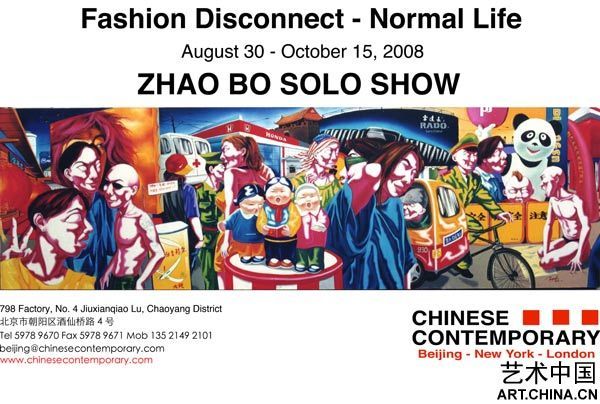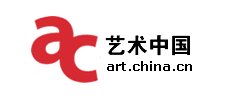
中国当代
赵波个展 - “与流行无关”
2008年8月30日-10月15日
开幕式: 2008年8月30日下午三点
中国当代画廊很荣幸地向大家发布艺术家赵波个展的消息。艺术家准备了15幅油画作品,将于2008年8月30日-10月15日在位于798工厂内的中国当代画廊展出。与此次展览相配备的画册也已印刷,届时,艺术家本人将会到场。
赵波毕业于四川美术学院,作为“新现实主义”的一份子,赵波展示了他对传统现实主义在当代艺术范畴内的解释,所针对的对象是现今的城市,不同于早期带有政治含义的先锋派艺术。新现实主义艺术成长在政治相对稳定的时代,但问题还是有的,那就是将历史与霓虹灯辐照下的大好未来相结合。赵波的作品由雄浑的颜色与人物的肖像画相接而成,展现了当下消费主义带给原先人民公社式社会环境的变化。赵波于70年代出生,生长在一个将中西方文化合璧-中山装与Gucci, 四合院与摩天大楼的时代,在毛泽东时代的集体主义与1979年邓小平时代的改革开放两套领导路线之间,艺术家找到了创作的灵感,使其作品更有深度。
最近,赵波从中国人口拥有3000万人口的重庆迁至中国的文化中心北京,让他更强烈地感受到了名牌文化对城市的侵蚀,刻画了正在被各种快餐品牌,公司商标,饮料商标淹没的城市容貌,将其与拔地而起的城市建设相结合,在不协调的空间中,着重地展现了艺术家对这种不现实感觉的忧虑。艺术家将这种不现实的感觉,以“取而代之”的艺术手法得以体现,将阿迪达斯的商店,百事可乐的广告牌,大众汽车的甲壳虫取代了我们脚下真实的土地。
观众可以马上看见各种各样的商标如麦当劳,肯德鸡,可口可乐,米老鼠,但是画布上面的人物们却别有一番风趣。他们表情猥琐,好像隐藏着只有自己才知道的秘密。为了加深这种创作思维,艺术家故意将他们的视线不交错于参观人们的视线。画面上人物突出的眼球,无神的眼瞳散出的目光与画面形成锐角,好像在互相对视或者看着画布以外的什么东西。
除了大幅的油画,赵波的作品还包括小型的油画,将加重字体的西方商标与一件富有中国特色的文化物件摆放在一起,比如一盏灯笼,一颗红星。在这些小型油画中,赵波用中国的元素给轻飘飘代表消费主义的商标起着加重的作用。赵波的作品的共性,就是对消费主义的质问,质问它的享乐,它的贪婪,它那看似存在着的“富饶”。这些促成了人们心目中对西方商品的向往,这种向往什么时候会不会彻底地取代人们对中国的传统的向往?未来是无法预见的,但是赵波在自己的作品中捕捉到了21世纪全球化大方向下的中国,其生命力,其杂乱无章和自相的矛盾。
赵波的作品于国内外多次展出。收藏于多个收藏家及公共美术馆,如美国科罗拉多州Kent & Vicky Logan收藏系列,美国德克萨斯州Chaney Family收藏系列,美国丹佛美术博物馆,上海当代艺术馆, 深圳何香凝美术馆等。
[专稿] 赵波个展-“与流行无关”
Chinese Contemporary Gallery
Zhao Bo – FASHION DISCONNECT
August 30 – October 15, 2008
Opening: August 30, 2008, 3 pm
For immediate release – Chinese Contemporary Gallery is pleased to announce the opening of Zhao Bo’s solo exhibition FASHION DISCONNECT. The artist has prepared fifteen new paintings that will be on display 30 August – 15 October 2008 at Chinese Contemporary’s Beijing gallery in Factory 798. The opening will be 30 August 2008 at 3 pm and the artist will be present. A catalogue has been produced in conjunction with this exhibition.
A graduate of the Sichuan Academy of Fine Arts and a part of the “New Realists”, Zhao Bo demonstrates extraordinary talent in his interpretation of traditional realism within a contemporary stage, namely that of the modern Chinese city. Unlike the political motivations of earlier avant-garde artists, New Realists came to age in an era of relative political stability, when one of the most pressing dilemmas is the forced reconciliation of the past and the neon-lit future. Awash in bold colors and chaotic iconography, the artist’s canvases serve as portals into the fragmentation that consumerism has wrought upon China’s once communal experience. Born in the 1970s, Zhao Bo grew up in a country of immense transition – bridging the divide of West versus East, Mao jackets versus Gucci, hutongs versus skyscrapers. It is this tension between the societal juxtapositions of life under the collectivism of Mao’s rule and that of post-1979 Deng Xiaoping Reforms that lends poignancy to his works.
Having recently moved from Chongqing, the most populous city in China overflowing with more than thirty million residents, to Beijing, the country’s international capital, Zhao Bo has witnessed firsthand the advent of the name brand culture and its insidious infiltration of the urban landscape. The artist depicts his nation nearly choking in the suffocating grasp of fast food restaurants, corporate mascots, soda brands, and so on. Highlighting his concern with the frantic and multi-layered development of the contemporary Chinese city, the artist positions figures within an incongruous space. Zhao Bo hints at the impossibility of such an excessively cluttered cityscape by excluding solid ground. Instead, it is the compilation of the familiar products of our time – Adidas stores, Pepsi billboards, Volkswagon Beetles – that serve as a reference point for reality.
Though the logos of the international corporate giants strewn across the canvases - McDonalds, Kentucky Fried Chicken, Coca Cola, Mickey Mouse - are instantaneously accessible to the viewer, the figures embedded within their framework remain aloof. Their deviant facial expressions suggest a considerable inside joke acknowledged by those who have saturated themselves in this garish explosion of consumption. This is emphasized by the realization that not a single figure meets the audience’s gaze, rather their bulging eyes and emotionally void pupils are skewed at acute angles, either engaging each other or focused on a distant point far from the restrictive boundaries of the canvas.
In addition to large-scale paintings, Zhao Bo has also created smaller scale vignettes, placing a large, bold Western brand adjacent to something typically Chinese such as a lantern or red star. Within these paintings, Zhao Bo takes care to incorporate emblems of his country to serve as ballast against the kitsch logos that have become commonplace to most Chinese. As in all of his paintings, the artist seems to be asking, what is it about the consumerism, the greed, the insatiable ingestion of tangible ‘prosperity’ that has catalyzed the preoccupation with Western products and how long before this supercedes the semblance of a unified Chinese traditional culture? The future may be unclear, but Zhao Bo has captured the vitality, frenzy and contradictions of China’s 21st century globalization.
Zhao Bo's works have been shown extensively in China and abroad. They are in many prestigious collections, such as the Kent and Vicki Logan Collection in Colorado, the Chaney Family Collection in Texas and the Denver Art Museum. His paintings have been included in exhibitions at the Denver Art Museum, the Museum of Contemporary Art in Shanghai and the He Xiangning Art Museum in Shenzhen.
|

